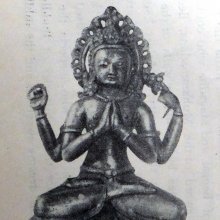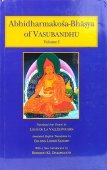Samgha, Sangha, Saṅgha, Saṃgha, Saṅghā: 32 definitions
Introduction:
Samgha means something in Buddhism, Pali, Hinduism, Sanskrit, Jainism, Prakrit, the history of ancient India, Marathi, Hindi. If you want to know the exact meaning, history, etymology or English translation of this term then check out the descriptions on this page. Add your comment or reference to a book if you want to contribute to this summary article.
Alternative spellings of this word include Sangh.
Images (photo gallery)
(+8 more images available)
In Hinduism
Dharmashastra (religious law)
Source: Wisdom Library: Dharma-śāstraSaṅgha (सङ्घ) refers to a ‘confederation’, composed of several persons following one ‘dharma,’ living in different places. The word is used throughout Dharmaśāstra literature such as the Manusmṛti. (See the Manubhāṣya, verse 8.219)

Dharmashastra (धर्मशास्त्र, dharmaśāstra) contains the instructions (shastra) regarding religious conduct of livelihood (dharma), ceremonies, jurisprudence (study of law) and more. It is categorized as smriti, an important and authoritative selection of books dealing with the Hindu lifestyle.
Pancaratra (worship of Nārāyaṇa)
Source: Shodhganga: Kasyapa Samhita—Text on Visha Chikitsa (p)Saṃgha (संघ) refers to a “cluster (of lightening)”, according to the second chapter of the Kāśyapa Saṃhitā: an ancient Sanskrit text from the Pāñcarātra tradition dealing with both Tantra and Viṣacikitsā (Toxicology).—Accordingly, text text dictates that a Garuḍa-upāsaka, the aspirant, must meditate on Garuḍa of the following form—The Kāśyapasaṃhitā describes the different forms of Garuḍa in the five bhūta-maṇḍalas on which the aspirant has to meditate upon to cure the snake-bite victim from the poison which could have killed him. Garuḍa as the ether element, ākāśa, is in dark colour amidst a cluster of lightening (vidyut-saṃgha-samākula).

Pancaratra (पाञ्चरात्र, pāñcarātra) represents a tradition of Hinduism where Narayana is revered and worshipped. Closeley related to Vaishnavism, the Pancaratra literature includes various Agamas and tantras incorporating many Vaishnava philosophies.
In Buddhism
Theravada (major branch of Buddhism)
Source: Access to Insight: A Glossary of Pali and Buddhist TermsOn the conventional (sammati) level, this term denotes the communities of Buddhist monks and nuns; on the ideal (ariya) level, it denotes those followers of the Buddha, lay or ordained, who have attained at least stream entry (see sotapanna), the first of the transcendent paths (see magga) culminating in nibbana. Recently, particularly in the West, the term "sangha" has been popularly adapted to mean the wider sense of "community of followers on the Buddhist path," although this usage finds no basis in the Pali canon. The term "parisa" may be more appropriate for this much broader meaning.Source: Pali Kanon: Pali Proper Names1. Sangha. An astrologer (samvacckarikanayaka) who predicted the destiny of Kitti (afterwards Vijayabahu I.). It was this prediction which made Buddharaja support Kitti. Cv.lvii.48.
2. Sangha. Father of Suranimmila; he was the father of seven sons and lived in Khandavitthika. Mhv.xxiii.19.
3. Sangha. An upasaka who will wait on Metteyya Buddha (Anagat. vs. 61) and be his chief lay patron. Ibid., 98.
4. Sangha. A minister of Dutthagamani. He gave alms, in circumstances that won applause from the deity of the kings parasol, to Mahanaga Thera of Kotagallapabbata, to a monk of Timbarugama, and to another of Devagirivihara and Cetiyapabbata. The king sent for him and made him Treasurer. It is probably this same Sangha that is mentioned in the Extended Mahavamsa (xxxii.246) as destined to become the chief patron of Matteyya Budda. His wife was Sanghadatta (q.v.). Ras.ii.75f, 180.
5. Sangha. A minister of Kakavannatissa; his brother was Cullasangha and his daughter Kincisangha. When the latter was taught cooking, the first meal she made was given to the monks. Thus she came to be called Sanghupatthayika. Later, she was abandoned by her parents at Nigrodhasalakhanda, but she was rescued by Sakka in the guise of a youth. She gave alms to a monk of Cittalapabbata when she had been starving for seven days, and also gave her only garment, herself wearing leaves. The king heard of this from the deity of his parasol, and, having sent for her, gave her in marriage to one of his sons. Ras.ii.45f.
Sangha Sutta. The Buddha tells Upali of ten things which disunite the Order and their ten opposites which unite it. A.v.73.
-- or --
1. Sangha Theri. She belonged to Prince Siddhatthas court, and having joined the Order with Pajapati Gotami, became an arahant. Thig. vs. 18; ThigA.24.
2. Sangha. Daughter of Mahanama and step sister of Sotthisena. She killed Sotthisena and gave the kingdom to her husband, who was his umbrella bearer, but he died within a year. Cv.xxxviii.1f.
3. Sangha. Wife of King Manavamma. She was the daughter of the Malayaraja Sanghasena. Cv.xlvii.3, 8.
4. Sangha. Daughter of Aggabodhi VI. and wife of Aggabodhi VII. Her husband once struck her in anger, and, when she complained to her father, he sent her to a nunnery. There her maternal cousin, also called Aggabodhi, became friendly with her and ran away with her to Rohana. But her husband made war on him and seized both him and Sangha. After that husband and wife lived in peace. Cv.x1viii.54ff.
5. Sangha. Mahesi of Sena I. She and her husband built the Pubbarama and the Sanghasenarama in the Mahavihara. Sangha also built the Uttara vihara and the Mahindasena parivena. Cv.l.7, 69, 79.
6. Sangha. Daughter of Kittaggabodhi and Deva and wife of Sena II. She had a son (Kassapa V.).Source: Dhamma Dana: Pali English Glossary
M Community of bhikkhus, established by Buddha.
The raison detre of the sangha is to transmit the sasana and to preserve it. To do so, the mode of functioning of this community is entirely ruled by the vinaya that the Perfect one has established. If such wasnt the case, his teaching would have disappeared since quite long. It could have never, twenty five centuries after Buddhas parinibbana, been still brought to the acknowledgement of mankind, neither being practised, nor being realised.
Remark: We most often see this word written as "sangha" instead of "sangha". It is however a mistake. In accordance with the Pali transcribing or transliteration, the combination "san" does not exist, or then we do obtain "sa + ngha", which calls for a different pronunciation (close to "sana").
See also: sangha
Source: Pali Kanon: Manual of Buddhist Terms and Doctrines(lit.: congregation), is the name for the Community of Buddhist monks.
As the third of the Three Gems or Jewels (ti-ratana) and the Three Refuges (ti-sarana), i.e. Buddha, Dhamma and Sangha, it applies to the ariya-sangha, the community of the saints, i.e. the 4 Noble Ones (ariya-pugga), the Stream-winner, etc.
Theravāda is a major branch of Buddhism having the the Pali canon (tipitaka) as their canonical literature, which includes the vinaya-pitaka (monastic rules), the sutta-pitaka (Buddhist sermons) and the abhidhamma-pitaka (philosophy and psychology).
Mahayana (major branch of Buddhism)
Source: Wisdom Library: Maha Prajnaparamita SastraSaṃgha (संघ) refers to an “assembly” according to the 2nd century Mahāprajñāpāramitāśāstra chapter VI. Accordingly, “the gathering together of many Bhikṣus in one place is called saṃgha. The Bhikṣus must be gathered together to constitute a saṃgha”.
There are four types of saṃgha:
- the assembly having shame (hrīmat),
- the shameless saṃgha (āhrīkya),
- the assembly of dumb sheep (eḍamūka),
- the true saṃgha (bhūta).
Saṃgha (संघ) refers to a “congregation” (e.g., of Bodhisattvas), according to the Gaganagañjaparipṛcchā: the eighth chapter of the Mahāsaṃnipāta (a collection of Mahāyāna Buddhist Sūtras).—Accordingly: “[...] Again, Śāriputra, it is not easy to express the splendor of the virtues of that Tathāgata’s Buddha-field, remaining here with a life-span of a world-age. Śāriputra, the whole retinue of that Tathāgata reached to thousands of world-sphere, and the congregation of the Bodhisattvas (bodhisatva-saṃgha) was incalculable’”.

Mahayana (महायान, mahāyāna) is a major branch of Buddhism focusing on the path of a Bodhisattva (spiritual aspirants/ enlightened beings). Extant literature is vast and primarely composed in the Sanskrit language. There are many sūtras of which some of the earliest are the various Prajñāpāramitā sūtras.
General definition (in Buddhism)
Source: Wisdom Library: Dharma-samgrahaSaṅgha (सङ्घ) or Saṃgha is the third of the “three treasures” (triratna) defined in the Dharma-saṃgraha (section 1). The Dharma-samgraha (Dharmasangraha) is an extensive glossary of Buddhist technical terms in Sanskrit (e.g., triratna and saṅgha). The work is attributed to Nagarguna who lived around the 2nd century A.D.
Saṅgha or Saṅghānusmṛti refers to one of the “six recollections” (anusmṛti) as defined in the Dharma-saṃgraha (section 54).
Source: Wisdom Library: BuddhismSangha:—All followers of the teachings of the Buddha.
Source: Buddhist Door: GlossaryThe Buddhist monastic order. The corporate assembly of at least 3 monks under a chairman, empowered to hear confession, grant absolution and ordain. In general terms, it refers to any community practising the Buddhist Way.Source: Amaravati: Glossarythe community of those who practise the Buddhas Way. More specifically, those who have formally committed themselves to the lifestyle of a mendicant monk or nun.
Source: Shambala Publications: GeneralSangha (samgha), Skt., lit., “crowd, host”; the Buddhist community. In a narrower sense the sangha consists of monks (bhikshu), nuns (bhikshunī), and novices (shrāmanera). In a wider sense the sangha also includes lay followers.
In Jainism
General definition (in Jainism)
Source: Wisdom Library: JainismSaṃgha (संघ, “congregation”) refers to “attributing faults the congregation of ascetics” and is one of the causes leading to the influx (āsrana) of faith-deluding (darśana-mohanīya) karmas.
Saṃgha is a Sanskrit technical term defined in the Tattvārthasūtra (ancient authorative Jain scripture) from the 2nd century, which contains aphorisms dealing with philosophy and the nature of reality.
Source: archive.org: TrisastisalakapurusacaritraSaṅgha (सङ्घ) refers to a “group of Gaṇas” and represents one of the ten persons suitable for rendering services, according to chapter 1.1 [ādīśvara-caritra] of Hemacandra’s 11th century Triṣaṣṭiśalākāpuruṣacaritra: an ancient Sanskrit epic poem narrating the history and legends of sixty-three illustrious persons in Jainism.—Accordingly, “[...] Vajranābha acquired strong Tirthakṛt-body-making and family-karma by the twenty sthānakas as follows:—[...] The sixteenth sthāna is the rendering of service by food, drink, etc., to the ten persons, Ācārya, etc. [viz., Saṅgha] [...]”.
Note: The 10 persons entitled to service are; [viz., Saṅgha (a group of Gaṇas);].—(cf. Aupapātikasūtra 20, p. 43. Sthānāṅgasūtra 397, p. 299. Āvaśyakasūtra 176-78, p. 161b). [...] These 10 persons are entitled to 13 kinds of service: giving of food; of drink; giving a seat; supplying anything that may be lacking in his equipment; cleansing the feet; giving of clothes; giving of medicine; escort on the road; protection from rogues, thieves, etc.; taking the staff when he enters the house; and 3 kinds of sanitary service.—(cf. Āvaśyakasūtra p. 161b).
Source: Shodhganga: A cultural study on the jain western Indian illustrated manuscriptsSaṅgha (सङ्घ).—The Jain Order is known as the Jain saṅgha. The current Jain saṅgha was re established by Mahāvīra who was the 24th and last tīrthankara of the current time period.
The Jain saṅgha is composed of the following four groups.
- sādhus (monks)
- sādhvis (nuns)
- śrāvakas (male householders)
- śrāvikās (female householders)
1) Saṃgha (संघ).—What is meant by the congregation of ascetics or religious order (saṃgha)? The group of ascetics endowed with right perception-knowledge-conduct is called congregation (saṃgha).
What is meant by finding faults in the congregation (saṃgha-avarṇavāda)? To find faults in the nirgrantha monks, nuns, laity, etc who is a part of congregation (and are detached from their body and worldly possessions and things) and say that they are not the real as prescribed in the scriptures is called finding faults in the congregation.
2) Saṃgha (संघ).—One of the ten types of ‘nursing services’ (vaiyāvrata)? What is meant by ‘the four fold congregation of the monks, nuns, votary men and votary women’ (saṃgha)? Congregation of the four folds /orders namely monks, votary men, votary women and nuns is called saṃgha. Alternatively congregation of ṛṣis, yatis, munis and totally detached from the household (anagāra) is called congregation or holy-gathering.

Jainism is an Indian religion of Dharma whose doctrine revolves around harmlessness (ahimsa) towards every living being. The two major branches (Digambara and Svetambara) of Jainism stimulate self-control (or, shramana, ‘self-reliance’) and spiritual development through a path of peace for the soul to progess to the ultimate goal.
India history and geography
Source: Cologne Digital Sanskrit Dictionaries: Indian Epigraphical GlossarySaṅgha.—(ASLV), a social organisation. (BL), a community of Buddhist monks; the Buddhist Church. (HA), a Jain congregation; the Jain Church (made up of four constituents, viz. sādhu, sādhvī, śrāvaka and śrāvikā) also called Jaina-saṅgha; a group of pilgrims going together on pilgrimage under the leadership of a Saṅghapati (q. v.). (EI 22), a tribe. Cf. Tamil saṅgam (q. v.). Note: saṅgha is defined in the “Indian epigraphical glossary” as it can be found on ancient inscriptions commonly written in Sanskrit, Prakrit or Dravidian languages.

The history of India traces the identification of countries, villages, towns and other regions of India, as well as mythology, zoology, royal dynasties, rulers, tribes, local festivities and traditions and regional languages. Ancient India enjoyed religious freedom and encourages the path of Dharma, a concept common to Buddhism, Hinduism, and Jainism.
Languages of India and abroad
Pali-English dictionary
Source: BuddhaSasana: Concise Pali-English Dictionarysaṅgha : (m.) a multitude; an assemblage; the Buddhist clergy.
Source: Sutta: The Pali Text Society's Pali-English DictionarySaṅgha, (fr. saṃ+hṛ; lit. “comprising. ” The quâsi pop. etym. at VvA. 233 is “diṭṭhi-sīla-sāmaññena saṅghāṭabhāvena saṅgha”) 1. multitude, assemblage Miln. 403 (kāka°); J. I, 52 (sakuṇa°); Sn. 589 (ñāti°); 680 (deva°); D. III, 23 (miga°); Vv 55 (accharā°=samūha VvA. 37). bhikkhu° an assembly of Buddhist priests A. I, 56, etc.; D. I, 1, etc.; S. I, 236; Sum I. 230, 280; Vin. I, 16; II, 147; bhikkhunī° an assembly of nuns S. V, 360; Vin. I, 140; sāvaka° an assembly of disciples A. I, 208; D. II, 93; S. I, 220; PvA. 195, etc.; samaṇa° an assembly of ascetics Sn. 550.—2. the Order, the priesthood, the clergy, the Buddhist church A. I, 68, 123, etc.; D. I, 2, etc.; III, 102, 126, 193, 246; S. IV, 270 sq.; Sn. 227, etc.; J. II, 147, etc.; Dhs. 1004; It. 11, 12, 88; Vin. I, 102, 326; II, 164, etc. ‹-› 3. a larger assemblage, a community A. II, 55=Sv. 400; M. I, 231 (cp. gaṇa).—On the formula Buddha, Dhamma, Sṅngha see dhamma C 2.

Pali is the language of the Tipiṭaka, which is the sacred canon of Theravāda Buddhism and contains much of the Buddha’s speech. Closeley related to Sanskrit, both languages are used interchangeably between religions.
Marathi-English dictionary
Source: DDSA: The Molesworth Marathi and English Dictionarysaṅgha (संघ).—m S An assembly, a multitude; a collection, an assemblage; a number (of things animate or inanimate, but esp. of living beings) gathered together.
Source: DDSA: The Aryabhusan school dictionary, Marathi-Englishsaṅgha (संघ).—m An assembly, multitude; a collec- tion. saṅghaśakti The power of union, the corporate power.
--- OR ---
saṅgha (संघ).—f Junction; joint; a gap.
Marathi is an Indo-European language having over 70 million native speakers people in (predominantly) Maharashtra India. Marathi, like many other Indo-Aryan languages, evolved from early forms of Prakrit, which itself is a subset of Sanskrit, one of the most ancient languages of the world.
Sanskrit dictionary
Source: DDSA: The practical Sanskrit-English dictionarySaṃgha (संघ).—
1) A group, collection, multitude, flock; as महर्षिसंघ, मनुष्यसंघ (maharṣisaṃgha, manuṣyasaṃgha) &c.; सिद्धचारणसंघानां बभूव प्रियदर्शनः (siddhacāraṇasaṃghānāṃ babhūva priyadarśanaḥ) Mahābhārata (Bombay) 1.12.1.
2) A number of people living together.
3) Close contact or combination.
Derivable forms: saṃghaḥ (संघः).
Source: Cologne Digital Sanskrit Dictionaries: Shabda-Sagara Sanskrit-English DictionarySaṅgha (सङ्घ).—n.
(-ṅghaṃ) 1. Flock, multitude, number, a collection of living beings either of the same or different species. 2. A heap, a quantity in general. 3. A number of people living together. E. sam before han to kill or hurt, aff. ghañ .
Source: Cologne Digital Sanskrit Dictionaries: Benfey Sanskrit-English DictionarySaṃgha (संघ).—i. e. sam-han, m. 1. Multitude, [Indralokāgamana] 1, 36. 2. Flock, [Harivaṃśa, (ed. Calc.)] 8788. 3. Quantity. 4. Inhabitants, [Mānavadharmaśāstra] 8, 219.
Source: Cologne Digital Sanskrit Dictionaries: Cappeller Sanskrit-English DictionarySaṃgha (संघ).—[masculine] band, company, crowd.
Source: Cologne Digital Sanskrit Dictionaries: Monier-Williams Sanskrit-English Dictionary1) Saṃgha (संघ):—[=saṃ-gha] [from saṃ-han] a etc. See sub voce
2) [=saṃ-gha] b m. ([from] sam + √han) ‘close contact or combination’, any collection or assemblage, heap, multitude, quantity, crowd, host, number (generally with [genitive case] [plural] or ifc., e.g. muni-s, ‘a multitude of sages’ [Bhāgavata-purāṇa]; śatru-s, a host of enemies, [Rājataraṅgiṇī]), [Mahābhārata; Kāvya literature] etc.
3) [v.s. ...] any number of people living together for a certain purpose, a society, association, company, community
4) [v.s. ...] a clerical community, congregation, church, [Manu-smṛti; Sāhitya-darpaṇa] etc.
5) [v.s. ...] ([especially]) the whole community or collective body or brotherhood of monks (with Buddhists; also applied to a monkish fraternity or sect among Jainas), [Buddhist literature; Sarvadarśana-saṃgraha; Monier-Williams’ Buddhism 176.]
Source: Cologne Digital Sanskrit Dictionaries: Yates Sanskrit-English DictionarySaṅgha (सङ्घ):—(ṅghaṃ) 1. n. Flock, number, heap, multitude.
Source: DDSA: Paia-sadda-mahannavo; a comprehensive Prakrit Hindi dictionary (S)Saṃgha (संघ) in the Sanskrit language is related to the Prakrit word: Saṃgha.
[Sanskrit to German]
Sanskrit, also spelled संस्कृतम् (saṃskṛtam), is an ancient language of India commonly seen as the grandmother of the Indo-European language family (even English!). Closely allied with Prakrit and Pali, Sanskrit is more exhaustive in both grammar and terms and has the most extensive collection of literature in the world, greatly surpassing its sister-languages Greek and Latin.
Hindi dictionary
Source: DDSA: A practical Hindi-English dictionarySaṃgha (संघ) [Also spelled sangh]:—(nm) a federation; union; league, organisation, association; ~[cārī] gregarian, moving in groups: —[nyāyālaya] Union court; -[bhīva/bhāvanā/vṛtti] esprit de corps, team spirit; ~[vāda] federalism; ~[vādī] a federalist; federalistic.
...
Prakrit-English dictionary
Source: DDSA: Paia-sadda-mahannavo; a comprehensive Prakrit Hindi dictionary1) Saṃgha (संघ) in the Prakrit language is related to the Sanskrit word: Kath.
2) Saṃgha (संघ) also relates to the Sanskrit word: Saṃgha.
Prakrit is an ancient language closely associated with both Pali and Sanskrit. Jain literature is often composed in this language or sub-dialects, such as the Agamas and their commentaries which are written in Ardhamagadhi and Maharashtri Prakrit. The earliest extant texts can be dated to as early as the 4th century BCE although core portions might be older.
Kannada-English dictionary
Source: Alar: Kannada-English corpusSaṃgha (ಸಂಘ):—
1) [noun] a number of persons or things gathered closely together; a group; a cluster; an agregation.
2) [noun] an organisation of persons having common interests, purposes, etc.; a society; a league; an association.
3) [noun] the fact of being associated with another person or persons.
4) [noun] an association of Tamil scholars, writers, etc., for advancing literature, patronised by Pānḍya kings in Tamil Nadu.
5) [noun] (jain.) a congregation of jaina monks.
6) [noun] (buddh.) a congregation of buddhist monks.
Kannada is a Dravidian language (as opposed to the Indo-European language family) mainly spoken in the southwestern region of India.
See also (Relevant definitions)
Starts with (+115): Samghaa, Samghabhadra, Samghabheda, Samghabhedaka, Samghabodhi, Samghacarin, Samghacharin, Samghada, Samghada, Samghada, Samghadaga, Samghadana, Samghadasa, Samghaddana, Samghadhipa, Samghadhipatyavada, Samghadi, Samghadia, Samghadvara, Samghaguhya.
Ends with (+18): Arya Samgha, Aryasamgha, Asamgha, Bhikshusamgha, Bhutasamgha, Bodhisattvasamgha, Bodhisatvasamgha, Buddhadharmasamgha, Devasamgha, Dravidasamgha, Dravilasamgha, Ganasangha, Gramasamgha, Karmikasamgha, Krimisamgha, Maharshisamgha, Mulasamgha, Pakshisamgha, Patrakara-samgha, Payalisamgha.
Full-text (+2102): Samghashas, Samghapatitva, Ratnatraya, Samghavrittita, Samghi, Samghagupta, Samghadhipa, Samghapati, Samghacarin, Sangh, Sanghacarin, Samghavritti, Samghatala, Samgharakshita, Sanghajivin, Samghavardhana, Samghamitra, Samghaguhya, Samghadasa, Samghabhadra.
Relevant text
Search found 197 books and stories containing Samgha, Sangha, Saṅgha, Saṃgha, Saṅghā, Sam-gha, Saṃ-gha; (plurals include: Samghas, Sanghas, Saṅghas, Saṃghas, Saṅghās, ghas). You can also click to the full overview containing English textual excerpts. Below are direct links for the most relevant articles:
Puranic encyclopaedia (by Vettam Mani)
Garga Samhita (English) (by Danavir Goswami)
Verse 2.14.2 < [Chapter 14 - Description of Kāliya’s Story]
Verse 2.11.4 < [Chapter 11 - The Liberation of Dhenukāsura]
Verse 3.6.29 < [Chapter 6 - The Test of Śrī Kṛṣṇa]
Formal Education System in Ancient India (by Sushmita Nath)
Upasampadā (final ordination) < [Chapter 2 - Rituals of the Education System]
Debate and Discussion Method of Teaching < [Chapter 6 - Methods of Teaching and the Teacher–Student relationship]
Buddha Desana (by Sayadaw U Pannadipa)
Chapter 1 - His Noble Disciples < [Part IV - The Sangha]
Chapter 7 - The Holy Order Of The Sangha < [Part IV - The Sangha]
Chapter 4 - The Origin Of The Sangha < [Part IV - The Sangha]
Dipavamsa (study) (by Sibani Barman)
Chapter 2d - The Third Buddhist Council
Chapter 2c - The second Buddhist Council
Maha Prajnaparamita Sastra (by Gelongma Karma Migme Chödrön)
Part 6 - Honoring all the buddhas by means of a single offering < [Chapter XLIX - The Four Conditions]
I. Lists of recollections (anusmṛti or anussati) < [Preliminary note on the Eight Recollections]
Part 14 - Bringing innumerable beings to Arhathood by a single sermon < [Chapter LI - Seeing all the Buddha Fields]
Related products









